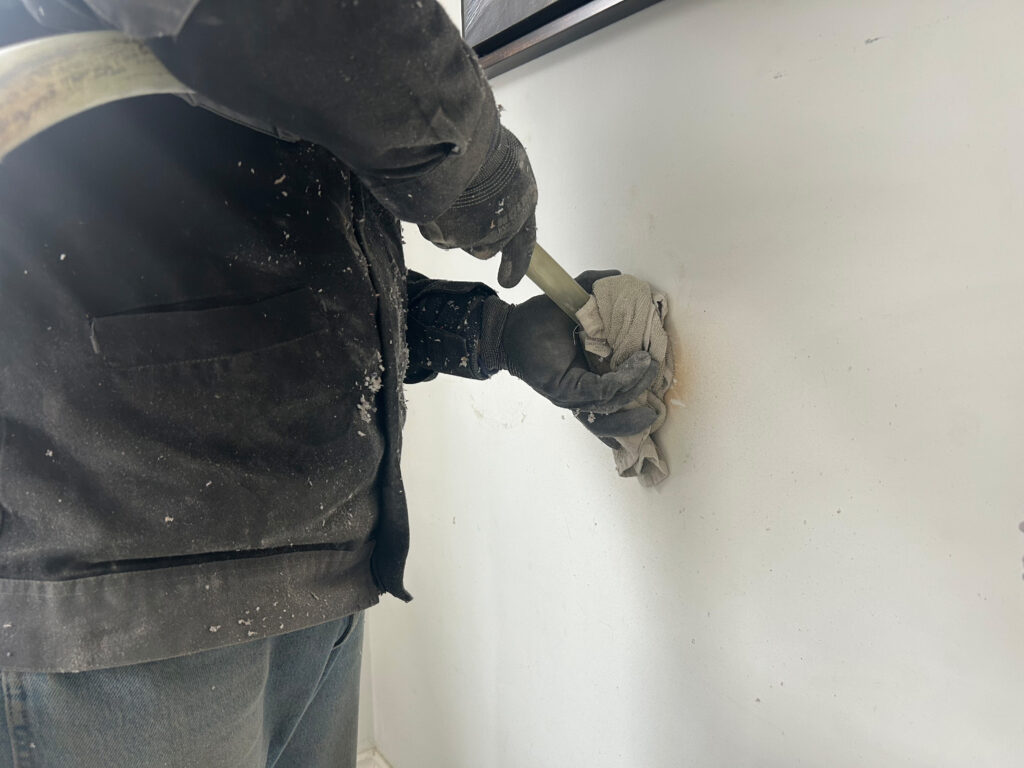


Wall-Ceiling Insulation
Drill and Fill method
Drill and Fill Wall-ceiling Insulation
Our drill and fill insulation service is an efficient solution for enhancing the energy efficiency of your home. By opening 4-inch holes in your drywall or plaster walls-ceiling, we inject high-quality cellulose insulation into the cavities. This process helps to significantly reduce heat loss, improve indoor comfort, and increase overall energy efficiency. Our insulation technique is ideal for both existing homes and those undergoing renovation, offering a seamless way to upgrade your home’s insulation without the need for extensive demolition.
Cellulose as a Sound Barrier
Cellulose insulation is an excellent choice for soundproofing, offering up to 80% sound absorption. It is highly effective in creating a sound barrier between floors or walls in both residential and commercial buildings. Whether you’re looking to reduce noise between rooms, units, or floors, cellulose provides a dense, environmentally friendly solution that helps to enhance privacy and comfort by minimizing sound transmission.
Government Rebates and Loans for Wall Insulation Upgrades in Ontario
In Ontario, homeowners can access government rebates and loans to upgrade wall insulation, especially for older homes. These programs are designed to improve energy efficiency, reduce heating and cooling costs, and enhance overall home comfort.
Please note that these programs and incentives may vary by location and have specific eligibility requirements. To make the most of these opportunities, consult with us. We’ll help you understand the available options and determine the best approach for your home.
Upgrade your Wall-Ceiling Insulation today & Receive Gov Rebate
Get Your Free Estimate Today! Experience exceptional customer support and enjoy affordable rates.
At Canada Green Insulation, we specialize in drill-and-fill cellulose insulation that enhances energy efficiency and provides up to 80% soundproofing. Our method effectively reduces noise and improves comfort, all while using environmentally friendly materials.
Dense Pack Wall Cellulose is fully approved by the Ontario Building Code
Dense-packed cellulose insulation in double stud walls offers high performance!
In 2005, Ontario designed and built Canada’s first Energy Star labelled home in Canada. This home was built with dense-packed (or dense-blown) cellulose as the wall insulation of choice. Their intent was to produce a better built home with the goal of creating “a proper balance between additional efficiency and price such that it would be attractive to future clients”.
Dense packing walls typically results in remarkable performance in the walls.
One of the most effective ways of dealing with existing uninsulated frame walls is to blow cellulose into the wall cavities. It is a popular and time-proven method of retrofitting insulation and is cost effective option for all houses. It is popular for good reason; it works very well.
Dense packing a wall does not eliminate the need for an air barrier in new construction. But in retrofit applications we often get so close that we can typically live without one. Besides, there are no other practical alternatives short of completely reconstructing the wall assembly. So “rock on” and dense pack walls. The approach is practical and cost effective.
The insulating value of cellulose is comparable to that of fiberglass batts; however, because cellulose is more resistant to airflow than fiberglass, it performs better. In a closed cavity, cellulose should be installed by the dense-pack method — that is, to a density of at least 3-1/2 lb. per cu. ft. When cellulose is installed in an existing building with empty stud cavities, it is usually blown through holes drilled in the exterior sheathing. This work typically requires the temporary removal of some of the building’s siding.
Cellulose As Sound Barrier.
Cellulose Is 80% Sound Proof Material which is Used for creating prefect sound barrier between floors or walls within different existing units in a residential/commercial building.
Cavities in an old home can be insulated using one of two methods:
1. Dry cellulose can be installed through gaps in the interior drywall.
2. Dry cellulose can be installed through holes in rigid-surface like Plaster or Drywall that has been installed on the interior side of studs or rafters.
Request Your Free Quote Today!
Please fill out the form below and one of our specialist will contact you.
Better to see you in person!
We value our customers! We’ll visit your home for a professional assessment, discuss your options, and answer all your questions – all for FREE.
Our Work
Where Comfort Meets Efficiency
